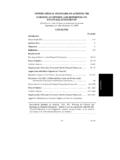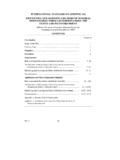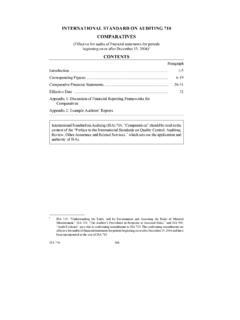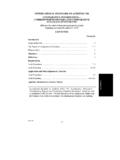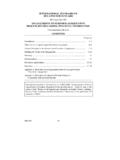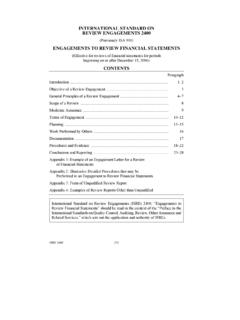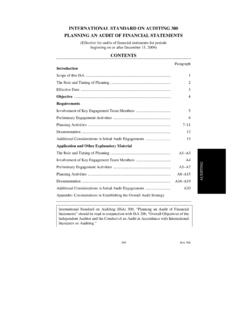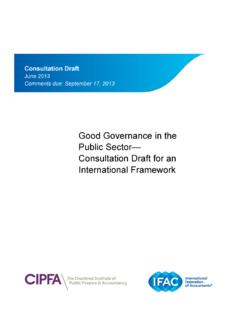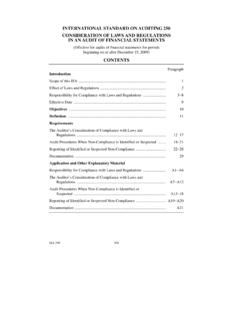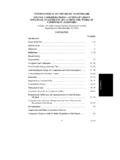Transcription of KEY ELEMENTS THAT CREATE AN ENVIRONMENT FOR AUDIT …
1 A FRAMEWORK FOR AUDIT QUALITY. KEY ELEMENTS THAT CREATE AN ENVIRONMENT FOR. AUDIT QUALITY. February 2014. This document was developed and approved by the International Auditing and Assurance Standards Board (IAASB). This IAASB develops auditing and assurance standards and guidance for use by all professional accountants under a shared standard-setting process involving the Public Interest Oversight Board, which oversees the activities of the IAASB, and the IAASB Consultative Advisory Group, which provides public interest input into the development of the standards and guidance. The objective of the IAASB is to serve the public interest by setting high-quality auditing, assurance, and other related standards and by facilitating the convergence of international and national auditing and assurance standards, thereby enhancing the quality and consistency of practice throughout the world and strengthening public confidence in the global auditing and assurance profession.
2 The structures and processes that support the operations of the IAASB are facilitated by the International Federation of Accountants (IFAC). Copyright February 2014 by the International Federation of Accountants (IFAC). For copyright, trademark, and permissions information, please see page 60. The IAASB's Vision for the Framework of AUDIT Quality The objectives of the Framework for AUDIT Quality include: Raising awareness of the key ELEMENTS of AUDIT quality. Encouraging key stakeholders to explore ways to improve AUDIT quality. Facilitating greater dialogue between key stakeholders on the topic. The IAASB expects that the Framework will generate discussion, and positive actions to achieve a continuous improvement to AUDIT quality. Auditors are required to comply with relevant auditing standards and standards of quality control within AUDIT firms, as well as ethics and other regulatory requirements.
3 The Framework is not a substitute for such standards, nor does it establish additional standards or provide requirements for the performance of AUDIT engagements. 1. Foreword Financial information should be relevant, timely and reliable to meet the needs of users. National laws and regulations, as well as an entity's stakeholders, often require an external AUDIT of some ELEMENTS of the financial information to give users confidence that the information can be trusted. For an external AUDIT to fulfill its objective the users of audited financial statements must have confidence that the auditor has worked to a suitable standard and that a quality AUDIT has been performed. The term AUDIT quality is frequently used in debates among stakeholders, in communications of regulators, standard setters, AUDIT firms and others, and in research and policy setting. AUDIT quality is a complex subject and, as outlined in Appendix 1, there is no definition or analysis of it that has achieved universal recognition.
4 For this reason, the International Auditing and Assurance Standards Board (IAASB) has developed a Framework for AUDIT Quality (the Framework) that describes the input-, process- and output factors that contribute to AUDIT quality at the engagement, AUDIT firm and national levels, for financial statement audits. The Framework also demonstrates the importance of appropriate interactions among stakeholders and the importance of various contextual factors. The IAASB believes that such a Framework is in the public interest as it will: Encourage national AUDIT firms, international networks of AUDIT firms, and professional accountancy organizations to reflect on how to improve AUDIT quality and better communicate information about AUDIT quality;. Raise the level of awareness and understanding among stakeholders of the important ELEMENTS of AUDIT quality;. Enable stakeholders to recognize those factors that may deserve priority attention to enhance AUDIT quality.
5 For example, the Framework could be used to inform those charged with governance about AUDIT quality and encourage them to consider their roles in enhancing it;. Assist standard setting, both internationally and at a national level. For example, the IAASB will use the Framework when it revises International Standard on Quality Control (ISQC) 11 and the International Standards on Auditing (ISAs). It may also assist the International Ethics Standards Board for Accountants (IESBA) and International Accounting Education Standards Board (IAESB). in considering improvements to their authoritative pronouncements;. Facilitate dialogue and closer working relationships between the IAASB and key stakeholders as well as among these key stakeholders themselves;. Stimulate academic research on the topic; and Assist students of auditing to more fully understand the fundamentals of the profession they are aspiring to join.
6 1. International Standard on Quality Control 1, Quality Control for Firms that Perform Audits and Reviews of Financial Statements, and Other Assurance and Related Services Engagements 2. A FRAMEWORK FOR AUDIT QUALITY: KEY ELEMENTS THAT CREATE AN ENVIRONMENT FOR AUDIT QUALITY. CONTENTS. Page Overview .. 4. 1 Input Factors .. 8. 2 Process Factors .. 12. 3 Output Factors .. 14. 4 Key Interactions within the Financial Reporting Supply Chain .. 19. 5 Contextual Factors .. 26. Appendix 1 The Complexity of Defining AUDIT Quality Appendix 2 Quality attributes of Input- and Process Factors 3. Overview 1. The term AUDIT quality encompasses the key ELEMENTS that CREATE an ENVIRONMENT which maximizes the likelihood that quality audits are performed on a consistent basis. 2. The objective of an AUDIT of financial statements is for the auditor to form an opinion on the financial statements based on having obtained sufficient appropriate AUDIT evidence about whether the financial statements are free from material misstatement and to report in accordance with the auditor's findings.
7 A quality AUDIT is likely to have been achieved by an engagement team that: Exhibited appropriate values, ethics and attitudes;. Was sufficiently knowledgeable, skilled, and experienced and had sufficient time allocated to perform the AUDIT work;. Applied a rigorous AUDIT process and quality control procedures that complied with law, regulation and applicable standards;. Provided useful and timely reports; and Interacted appropriately with relevant stakeholders. 3. The responsibility for performing quality audits of financial statements rests with auditors. However, AUDIT quality is best achieved in an ENVIRONMENT where there is support from, and appropriate interactions among, participants in the financial reporting supply chain. 4. The Framework is aimed at raising awareness of the key ELEMENTS of AUDIT quality, thereby encouraging auditors, AUDIT firms and other stakeholders to challenge themselves about whether there is more they can do to increase AUDIT quality in their particular environments.
8 5. The Framework applies to audits of all entities regardless of their size, nature, and complexity. It also applies to all AUDIT firms regardless of size, including AUDIT firms that are part of a network or association. However, the attributes of AUDIT quality described in this Framework vary in importance and affect AUDIT quality in different ways. 6. Auditors are required to comply with relevant auditing standards and standards of quality control for AUDIT firms, as well as ethics and other regulatory requirements. In particular, ISQC 12 addresses a firm 's responsibilities for its system of quality control for audits. The Framework is not a substitute for such standards, nor does it establish additional standards or provide procedural requirements for the performance of AUDIT engagements. 7. While the quality of an individual AUDIT will be influenced by the inputs, processes, outputs and interactions described in this Framework, the Framework for AUDIT Quality, by itself, is not sufficient for the purpose of evaluating the quality of an individual AUDIT .
9 This is because detailed consideration will need to be given to matters such as the nature, timing and extent of AUDIT 2. ISQC 1 requires AUDIT firms to establish and maintain a system of quality control to provide it with reasonable assurance that the firm and its personnel comply with professional standards and applicable legal and regulatory requirements; and that reports issued by the firm or engagement partners are appropriate in the circumstances. 4. evidence obtained in response to the risks of material misstatement in a particular entity, the appropriateness of the relevant AUDIT judgments made, and compliance with relevant standards. 8. The Framework distinguishes the following ELEMENTS : (a) Inputs (b) Process (c) Outputs (d) Key Interactions within the Financial Reporting Supply Chain (e) Contextual Factors The Framework can be depicted as follows: 5. Inputs 9. Inputs are grouped into the following input factors: (a) The values, ethics and attitudes of auditors, which in turn, are influenced by the culture prevailing within the AUDIT firm ; and (b) The knowledge, skills, and experience of auditors and the time allocated for them to perform the AUDIT .
10 10. Within these input factors, quality attributes are further organized between those that apply directly at: (a) The AUDIT engagement level;. (b) The level of an AUDIT firm , and therefore indirectly to all audits undertaken by that AUDIT firm ;. and (c) The national (or jurisdictional) level and therefore indirectly to all AUDIT firms operating in that country and the audits they undertake. 11. Appendix 2 describes, in more detail, the quality attributes of input factors for the engagement, firm , and national levels. 12. The inputs to AUDIT quality will be influenced by the context in which an AUDIT is performed, the interactions with key stakeholders and the outputs. For example, laws and regulations (context). may require specific reports (output) that influence the skills (input) utilized. Process 13. The rigor of the AUDIT process and quality control procedures impact AUDIT quality. Appendix 2.
